Gallery Network
7 Questions for Artist David Spriggs on Making Ethereal Sculptures Rooted in the ‘Language of the Immaterial’
The artist's solo show opens with Paul Kyle Gallery, Vancouver, on November 18.
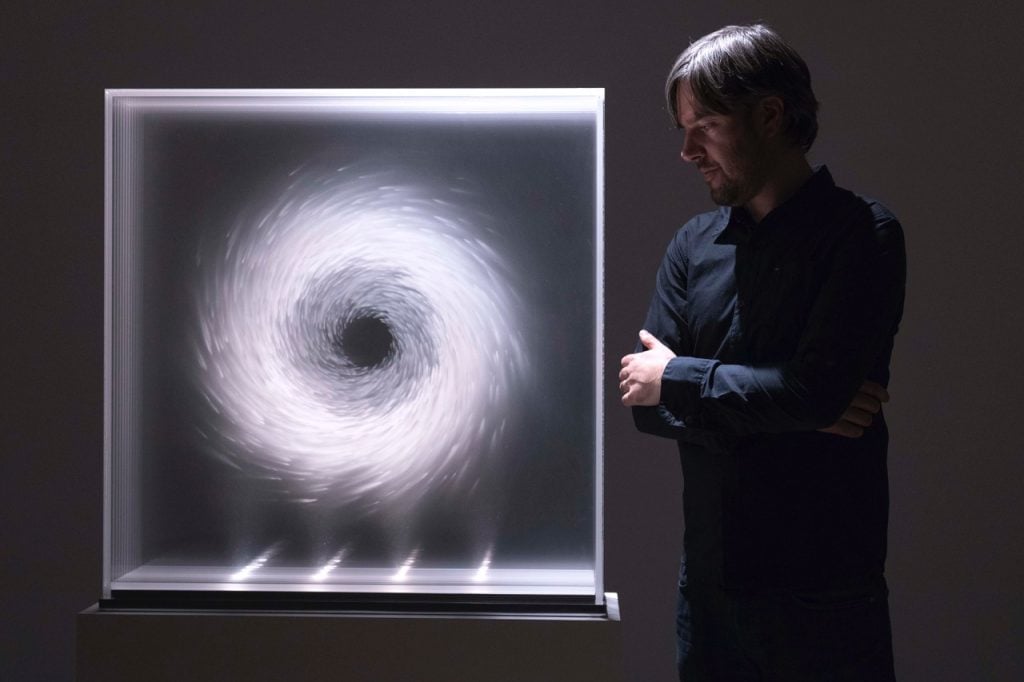
The artist's solo show opens with Paul Kyle Gallery, Vancouver, on November 18.

Artnet Gallery Network

Originally from the United Kingdom, Canadian-based artist David Spriggs creates genre-defying sculptures that operate between dimensions. Employing modern technology to create works—spanning from pedestal size to room-spanning installations—that are comprised of layered transparent images, though Spriggs work is evocative of Op art they are decidedly corporeal, with their approach firmly rooted in practical construction. Widely recognized for his immersive projects, such as Axis of Power (2009) produced for the 9th Sharjah Biennial, Spriggs interrogates the myriad ways humans experience the world both physically and psychologically.
Next month, Paul Kyle Gallery in Vancouver will present a solo exhibition of Spriggs work, which further highlights his engagement with philosophy, art history, and science through his artistic practice. On view from November 18, 2023, through January 20, 2024, the show offers viewers an opportunity to immerse themselves in the artist’s singular vision.
We recently reached out to Spriggs to learn more about what to expect in his forthcoming solo exhibition, and what goes into the creation of his visually alluring works, both creatively and technically.

David Spriggs, Red Wave (2022). Courtesy of the artist and Paul Kyle Gallery, Vancouver.
Your solo show opens with Paul Kyle Gallery next month, can you tell us a bit about the works going on view, and what visitors can expect?
In my upcoming solo exhibition “Dimensionalism” at the Paul Kyle Gallery, visitors can expect to be immersed in a collection of my artworks that explore notions of space, color symbolism, power, movement, and perception. “Dimensionalism” describes an art that embraces the in-between, an art of an interstitial space between dimensions.
As viewers move through the exhibition, they will encounter an interplay of layered, transparent imagery that unites into vibrant, abstract, and almost ethereal forms. These immaterial forms transcend the constraints of a single plane, forming a complex system of interconnected images perceived by the mind as a unified whole. It extends beyond visual layering, where viewers perceive each image not in isolation but as an integral part of a whole. Navigating this intricately layered space, dimensions blur and converge, and each of the artworks appears different from every viewpoint. Even the imagery itself blurs, blurring the boundaries of these immaterial forms.
Some of the smaller artworks in this exhibition were previously featured in Riyadh alongside my large-scale installation, Black & White. These pieces juxtapose the colors black and white, symbolizing duality. Exploring the psychology of “black and white” thinking or splitting, the artworks convey distinct meanings through color placement. Hierarchy suggests a power dynamic, akin to Rothko’s color placement, with one color above the other, while Dichotomy the two colors form a singular circular unified entity. Antithesis presents a blurred edge black square that transforms into a white square from the rear of the artwork, echoing Malevich’s black square and non-objectivity. This interplay points to the idea that the two colors rely on each other to exist.
Among the larger artworks in the exhibition are two pieces that evoke a wave-like form, conceptually linked to my 2020 installation First Wave, exhibited in Japan. First Wave referenced the pandemic and the historical significance of waves in Japanese art, as seen in Hokusai’s The Great Wave off Kanagawa. These new artworks employ color and form to express physical energy and turbulence, contrasting with the stillness of the imagery. Unlike traditional sculpture, they become atmospheric and free of boundaries.
Transparency also is a pivotal element in all my art and in the artworks in “Dimensionalism,” transcending mere translucency to become the language of the immaterial.
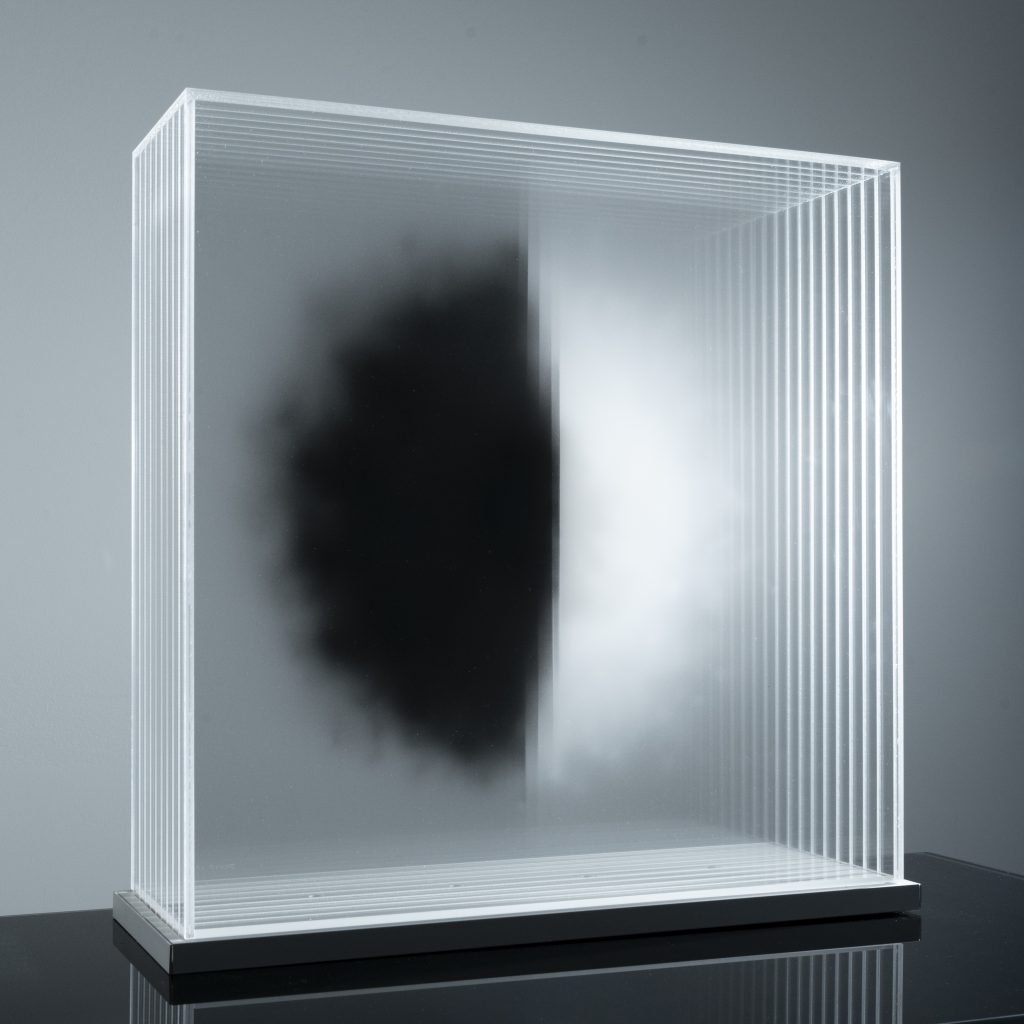
David Spriggs, Black and White Cloud (2022). Courtesy of the artist and Paul Kyle Gallery, Vancouver.
In what ways do you see these works continuing or diverging from themes you’ve worked with in your practice thus far?
In my new artworks, I continue to explore themes central to my artistic practice including phenomena, space-time, and movement, color, visual systems, the strategies and symbols of power, and the thresholds of form and perception.
What do you want visitors of the show to take away with them?
I hope visitors will be moved by the artworks and to consider the concepts behind each work.
How would you describe your creative process, where do you start?
My creative process starts with envisioning what I personally would find visually captivating and thought-provoking. I would then think about all the possible meanings and interpretations of a subject represented in a certain manner. From there, I would consider the context of the artwork in art history and if there are elements of the work I could add or remove to make it more intelligent and powerful. After refining the concept, I would finalize how it could be made in physical form.
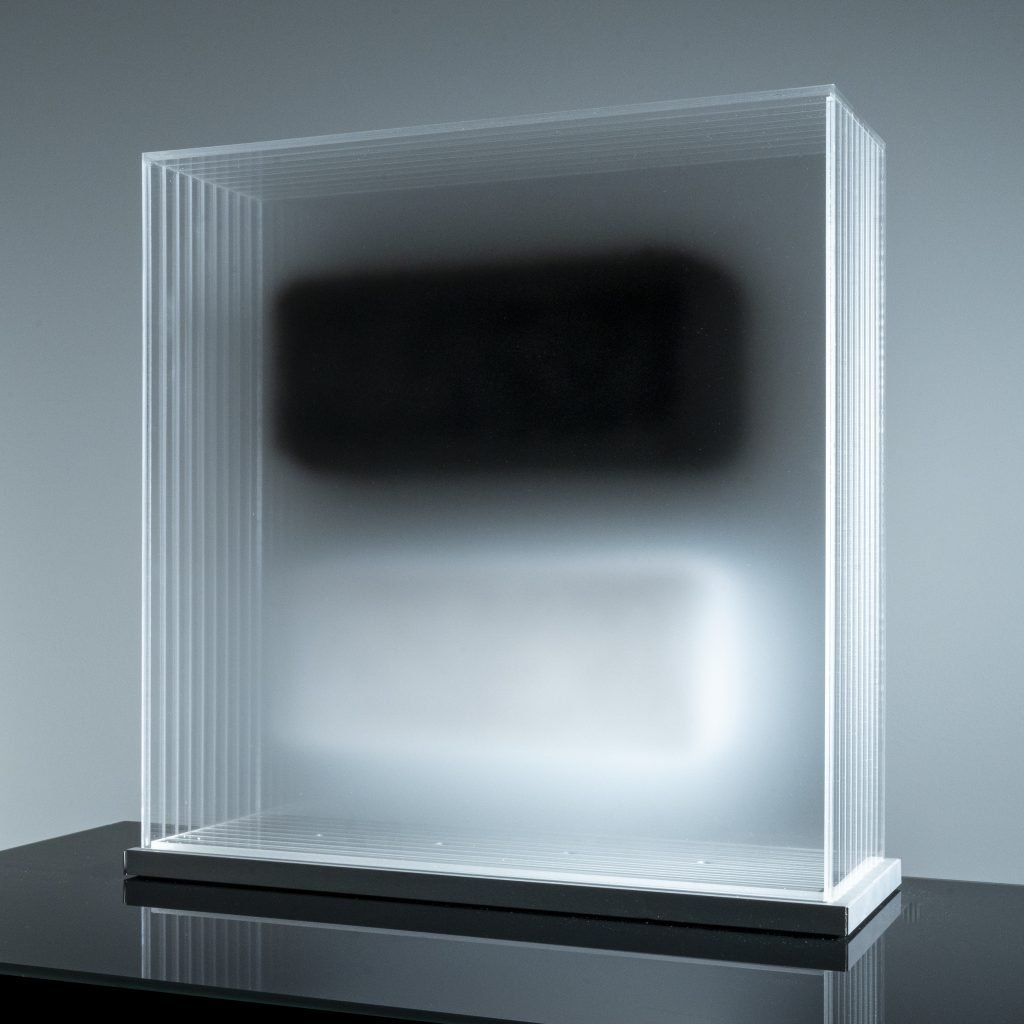
David Spriggs, Hierarchy (2022). Courtesy of the artist and Paul Kyle Gallery, Vancouver.
From a technical standpoint, what does your process involve? What goes into the fabrication of the various materials you work with?
My current aesthetics began in 1999 when I developed a technique of layering transparencies through space and painting on them. This method allowed me to create sculptures without traditional forms, using images to construct my art. Over time, I expanded this technique to create monumental works that offer viewers entirely new experiences. I have developed many possibilities within this layered space, leading to the distinctive style you see in my work today.
I have a particular affinity for making artwork by hand in a time that is saturated with computer-generated art. I really like the immediacy of painting and drawing and try to retain that aspect of artmaking in my work. However, I also use many other methods to create my work including photography and computer-based approaches.
Each artwork I conceive is unique, and during the design phase, I begin each artwork as though it was the first. Once the designs and choice of materials are finalized, I start on the laborious task of hand-painting each layer of an artwork in my studio. This meticulous process, though demanding, results in artworks that create strong connections with the viewer.
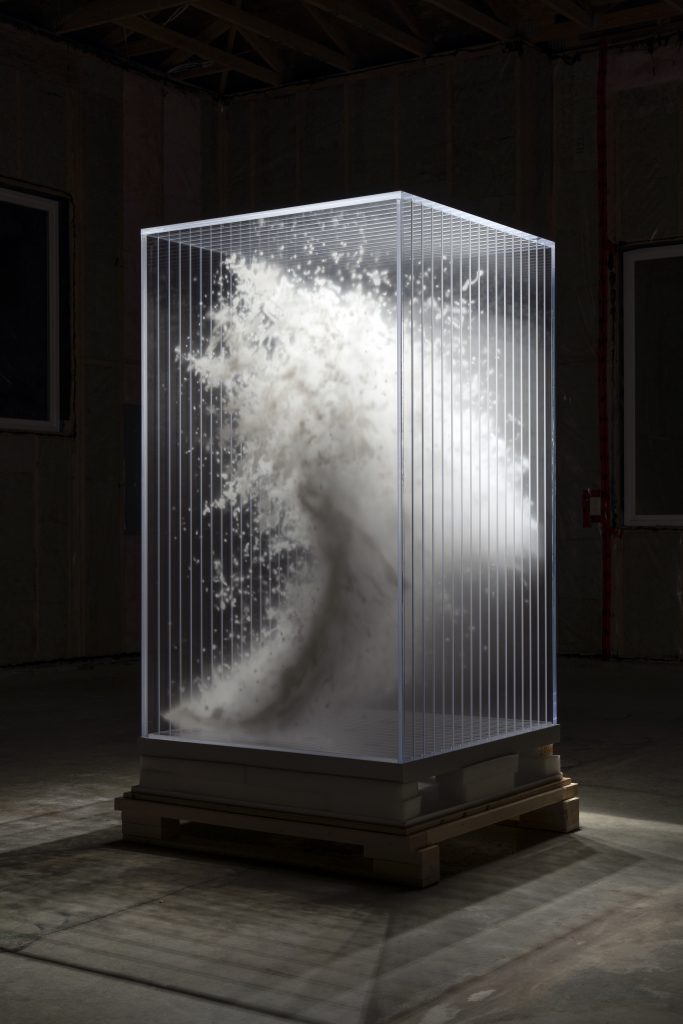
David Spriggs, Zenith (2020). Courtesy of the artist and Paul Kyle Gallery, Vancouver.
You’ve cited the “overlap between science, art, and philosophy” as a source of inspiration in your practice. Are there any scientists, artists, or philosophers that have influenced your work the most?
I am very interested in the works of prominent French theorists: Henri Bergson’s writing on time and space, Maurice Merleau-Ponty’s insights into phenomenology and its interplay with the human body, Paul Virilio’s concepts of speed and the collapsing of spatial dimensions, Jean Baudrillard’s writing on hyperreality and simulation, and Michel Foucault’s analysis of power dynamics. I am influenced by the writings of the Futurist Umberto Boccioni and his discussion of forms in space. The writings of the architect Rem Koolhaas are also very interesting to me.
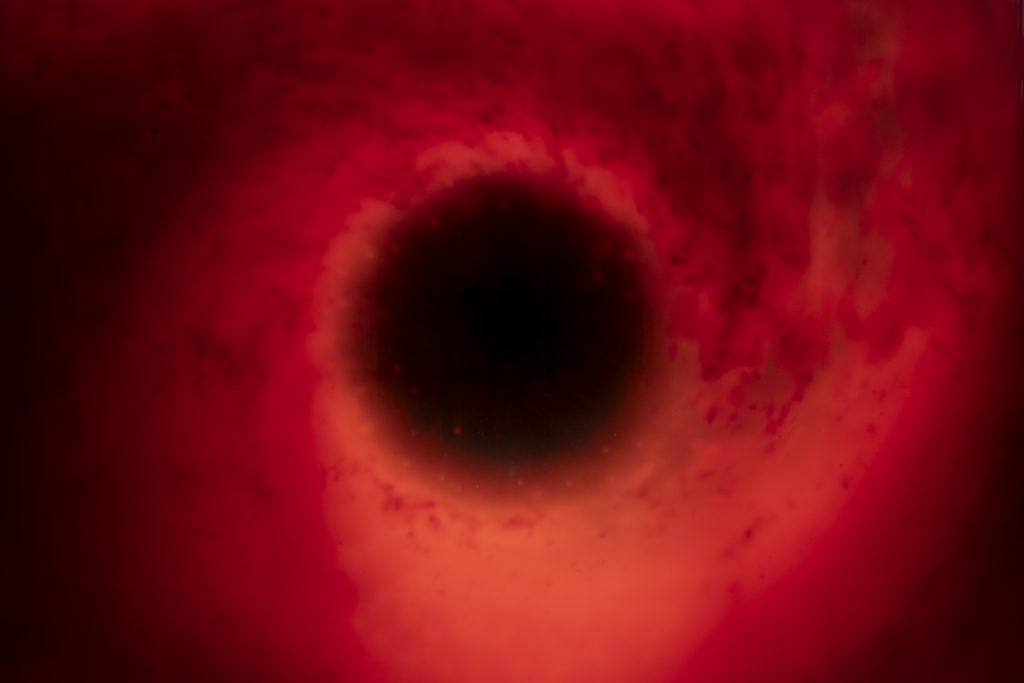
David Spriggs, Red Wave (detail) (2022). Courtesy of the artist and Paul Kyle Gallery, Vancouver.
What are you currently working on, or hope to work on next? Is there a project you want to tackle that you haven’t yet?
Over the past 24 years, I have produced a large number of artworks on color, collectively known as “Stratachromes.” The term “strata,” derived from Latin, conveys the concept of layers, while “chroma,” rooted in Greek, means color. In the upcoming phase of the “Stratachrome” project, I plan to embark on an exploration of multiple hues. Additionally, I have already started work on an ambitious “Stratachrome” installation dedicated to the color black. These artworks will center around the contemporary symbolic significance of colors, carrying an underlying political narrative.
The “Stratachrome” installation devoted to the color black will specifically address the theme of opacity as opposed to transparency, focusing on that which remains concealed or hidden from view. This exploration will be made through layered imagery, involving depictions of shadows and drawings, raising issues related to information control and censorship.
“David Sprigs: Dimensionalism” will be on view at Paul Kyle Gallery, Vancouver, November 18–January 20, 2023.
